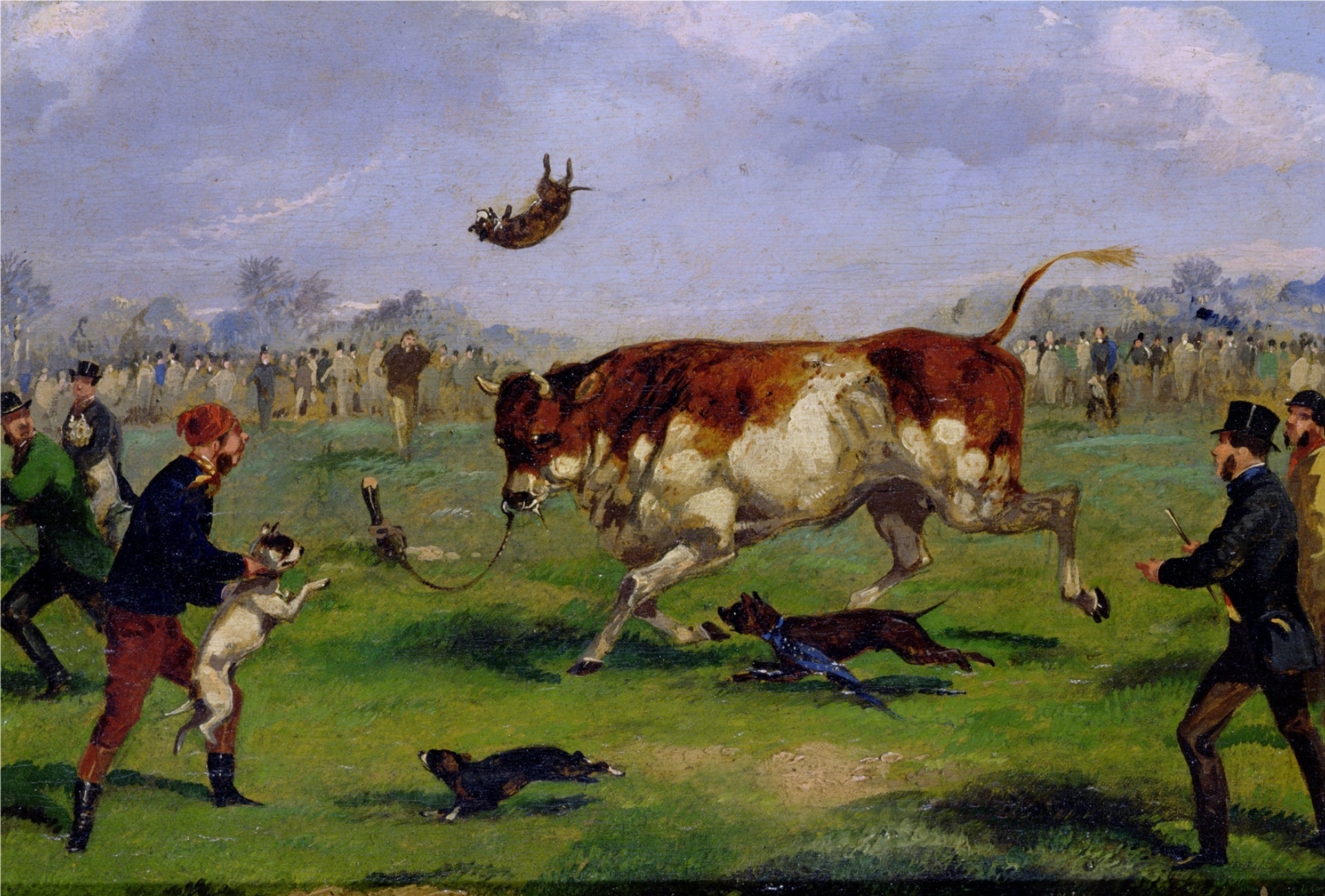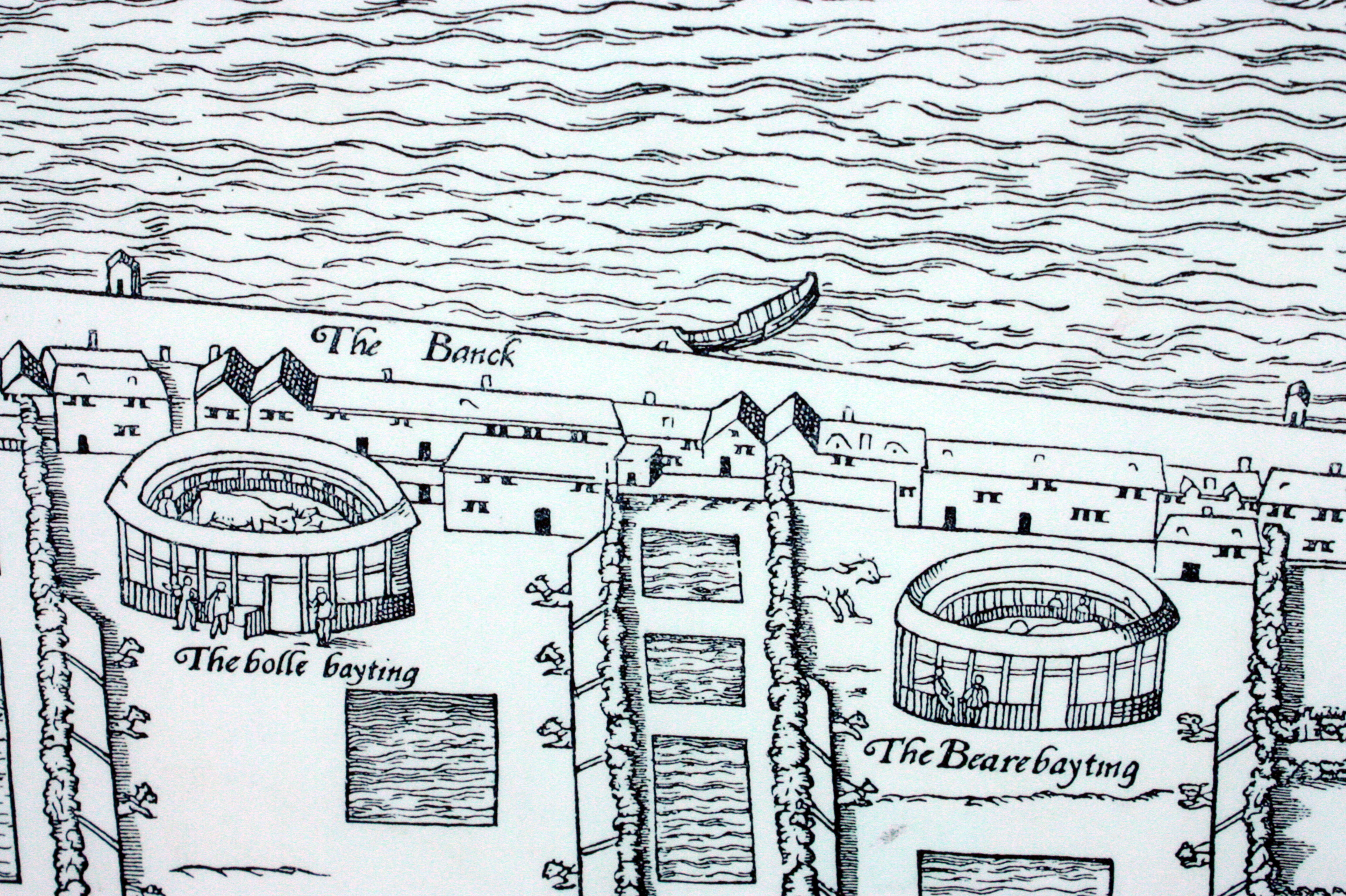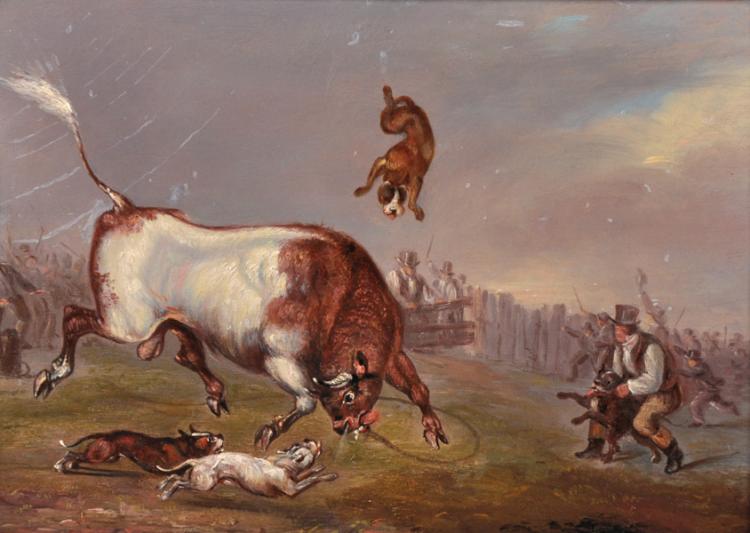Bull-baiting on:
[Wikipedia]
[Google]
[Amazon]

 Bull-baiting is a
Bull-baiting is a
 Crowds in London during the Royal Entry of
Crowds in London during the Royal Entry of  Bull-baiting was not only practiced as a form of recreation; there was a long-held belief that baiting improved the meat quality and tenderness when consumed. By the early nineteenth century, the sport began to die out, both because the baiting caused a public nuisance and because of new concerns about animal cruelty.
The Bull Baiting at
Bull-baiting was not only practiced as a form of recreation; there was a long-held belief that baiting improved the meat quality and tenderness when consumed. By the early nineteenth century, the sport began to die out, both because the baiting caused a public nuisance and because of new concerns about animal cruelty.
The Bull Baiting at
 In the 19th century, and during Spanish Colonial Rule, bulls used to be pitted against bears in
In the 19th century, and during Spanish Colonial Rule, bulls used to be pitted against bears in
 Bull-baiting
Bull-baiting
The Trial of 2 Centuries: Animal v. Animal Sport: Bull-Baiting
{{Baiting Baiting (blood sport) Bull sports

 Bull-baiting is a
Bull-baiting is a blood sport
A blood sport or bloodsport is a category of sport or entertainment that involves bloodshed. Common examples of the former include combat sports such as cockfighting and dog fighting, and some forms of hunting and fishing. Activities char ...
involving pitting a bull
A bull is an intact (i.e., not castrated) adult male of the species ''Bos taurus'' (cattle). More muscular and aggressive than the females of the same species (i.e., cows), bulls have long been an important symbol in many religions,
includin ...
against dog
The dog (''Canis familiaris'' or ''Canis lupus familiaris'') is a domesticated descendant of the wolf. Also called the domestic dog, it is derived from the extinct Pleistocene wolf, and the modern wolf is the dog's nearest living relative. Do ...
s.
History
England
James VI and I
James VI and I (James Charles Stuart; 19 June 1566 – 27 March 1625) was King of Scotland as James VI from 24 July 1567 and King of England and Ireland as James I from the union of the Scottish and English crowns on 24 March 1603 until ...
in March 1604 were entertained by bull-baiting. During the time of Queen Anne, bull-baiting was practised in London
London is the capital and List of urban areas in the United Kingdom, largest city of England and the United Kingdom, with a population of just under 9 million. It stands on the River Thames in south-east England at the head of a estuary dow ...
at Hockley-in-the-Hole, twice a week – and was also reasonably common in provincial towns, for instance at Birmingham
Birmingham ( ) is a City status in the United Kingdom, city and metropolitan borough in the metropolitan county of West Midlands (county), West Midlands in England. It is the second-largest city in the United Kingdom with a population of 1. ...
's Bull Ring. At Tutbury, a bull was tied to an iron stake so that it could move within a radius of about 30 feet. The object of the sport was for the dogs to immobilize the bull.
Before the event started, the bull's nose was blown full of pepper
Pepper or peppers may refer to:
Food and spice
* Piperaceae or the pepper family, a large family of flowering plant
** Black pepper
* ''Capsicum'' or pepper, a genus of flowering plants in the nightshade family Solanaceae
** Bell pepper
** Chili ...
to enrage it before the baiting. The bull was often placed in a hole in the ground. A variant of bull-baiting was "pinning the bull", where specially-trained dogs would set upon the bull one at a time, a successful attack resulting in the dog fastening his teeth strongly in the bull's snout. The extinct Old English Bulldog
The Old English Bulldog is an extinct breed of dog.
Physical characteristics
The Old English Bulldog was compact, broad and muscular, as reflected in the painting '' Crib and Rosa''. Through John Scott's engraving, this painting became th ...
was specially bred for this sport.
 Bull-baiting was not only practiced as a form of recreation; there was a long-held belief that baiting improved the meat quality and tenderness when consumed. By the early nineteenth century, the sport began to die out, both because the baiting caused a public nuisance and because of new concerns about animal cruelty.
The Bull Baiting at
Bull-baiting was not only practiced as a form of recreation; there was a long-held belief that baiting improved the meat quality and tenderness when consumed. By the early nineteenth century, the sport began to die out, both because the baiting caused a public nuisance and because of new concerns about animal cruelty.
The Bull Baiting at Wokingham
Wokingham is a market town in Berkshire, England, west of London, southeast of Reading, north of Camberley and west of Bracknell.
History
Wokingham means 'Wocca's people's home'. Wocca was apparently a Saxon chieftain who may ...
was advertised in the newspaper in 1774.
Bull baiting advertised in 1780 appears to indicate that it was organised by a local hostelry.
A Bill for the suppression of the practice was introduced into the House of Commons in 1800 by Sir William Pulteney. The Bill was defeated by a one-vote margin. A second Bill was introduced in 1802 by John Dent, but was defeated by thirteen votes. Bull baiting was still taking place, a newspaper reported in 1818 that a bull being taken from the stake to a stable had killed a man at Bilston Wake. Bulls were excluded from the protections afforded to other cattle in the Cruel Treatment of Cattle Act 1822. Bull-baiting was not finally outlawed until parliament passed the Cruelty to Animals Act of 1835, which forbade the keeping of any house, pit, or other place for baiting or fighting any bull, bear, dog, or other animal.
Ireland
Bull-baiting () was widespread inIreland
Ireland ( ; ga, Éire ; Ulster Scots dialect, Ulster-Scots: ) is an island in the Atlantic Ocean, North Atlantic Ocean, in Northwestern Europe, north-western Europe. It is separated from Great Britain to its east by the North Channel (Grea ...
in the 17th–19th centuries.
In Dublin
Dublin (; , or ) is the capital and largest city of Ireland. On a bay at the mouth of the River Liffey, it is in the province of Leinster, bordered on the south by the Dublin Mountains, a part of the Wicklow Mountains range. At the 2016 c ...
, bull-baiting took place near the Cornmarket and in Smithfield. On St Stephen's Day 1789, a riot followed a bull-bait: soldiers fired on the crowd and four were killed.
In Wexford
Wexford () is the county town of County Wexford, Ireland. Wexford lies on the south side of Wexford Harbour, the estuary of the River Slaney near the southeastern corner of the island of Ireland. The town is linked to Dublin by the M11/N11 ...
, the activity arrived in 1621, brought by the Guild of Butchers
A butcher is a person who may slaughter animals, dress their flesh, sell their meat, or participate within any combination of these three tasks. They may prepare standard cuts of meat and poultry for sale in retail or wholesale food establishm ...
; bulls were baited twice a year and their hides presented to the Mayor. The area where bull-baiting took place is still called the Bullring.
In Kilkenny it took place at the site called The Ring, first in 1609, and commonly on the feast-day of John the Baptist
John the Baptist or , , or , ;Wetterau, Bruce. ''World history''. New York: Henry Holt and Company. 1994. syc, ܝܘܿܚܲܢܵܢ ܡܲܥܡܕ݂ܵܢܵܐ, Yoḥanān Maʿmḏānā; he, יוחנן המטביל, Yohanān HaMatbil; la, Ioannes Bapti ...
(December 27). The last recorded bull-bait was in 1837, after they had become illegal under an 1835 Act.
Bull-baiting also took place in Waterford
"Waterford remains the untaken city"
, mapsize = 220px
, pushpin_map = Ireland#Europe
, pushpin_map_caption = Location within Ireland##Location within Europe
, pushpin_relief = 1
, coordinates ...
, Naas
Naas ( ; ga, Nás na Ríogh or ) is the county town of County Kildare in Ireland. In 2016, it had a population of 21,393, making it the second largest town in County Kildare after Newbridge.
History
The name of Naas has been recorded in th ...
, Drogheda, Tuam
Tuam ( ; ga, Tuaim , meaning 'mound' or 'burial-place') is a town in Ireland and the second-largest settlement in County Galway. It is west of the midlands of Ireland, about north of Galway city. Humans have lived in the area since the Bronz ...
, Carrickfergus
Carrickfergus ( , meaning " Fergus' rock") is a large town in County Antrim, Northern Ireland. It sits on the north shore of Belfast Lough, from Belfast. The town had a population of 27,998 at the 2011 Census. It is County Antrim's oldest ...
, Belfast
Belfast ( , ; from ga, Béal Feirste , meaning 'mouth of the sand-bank ford') is the capital and largest city of Northern Ireland, standing on the banks of the River Lagan on the east coast. It is the 12th-largest city in the United Kingdom ...
and Athlone.
North America
 In the 19th century, and during Spanish Colonial Rule, bulls used to be pitted against bears in
In the 19th century, and during Spanish Colonial Rule, bulls used to be pitted against bears in California
California is a state in the Western United States, located along the Pacific Coast. With nearly 39.2million residents across a total area of approximately , it is the most populous U.S. state and the 3rd largest by area. It is also the m ...
and Mexico
Mexico (Spanish: México), officially the United Mexican States, is a country in the southern portion of North America. It is bordered to the north by the United States; to the south and west by the Pacific Ocean; to the southeast by Guatema ...
. Kingsley (1920) said that the bulls that fought the bears, at least while California was part of the United States, were not domesticated Hereford bulls, but Spanish Fighting Bull
The Spanish Fighting Bull (Toro Bravo, ''toro de lidia'', ''toro lidiado'', ''ganado bravo'', ''Touro de Lide'') is an Iberian heterogeneous cattle population. It is exclusively bred free-range on extensive estates in Spain, Portugal, France an ...
s, whose weight, agility, speed, sharp horns and hot temper were said to be dangerous to both bears and humans, and Wistar (1937) said that those bulls were fearless. In a case of the bull winning, victory could come early, when the bull used its strength to gore the bear to death with its horns, or toss the bear into the air.
Dogs in bull baiting
 Bull-baiting
Bull-baiting dog
The dog (''Canis familiaris'' or ''Canis lupus familiaris'') is a domesticated descendant of the wolf. Also called the domestic dog, it is derived from the extinct Pleistocene wolf, and the modern wolf is the dog's nearest living relative. Do ...
s, including Old English Bulldog
The Old English Bulldog is an extinct breed of dog.
Physical characteristics
The Old English Bulldog was compact, broad and muscular, as reflected in the painting '' Crib and Rosa''. Through John Scott's engraving, this painting became th ...
s, Bullenbeisser
The Bullenbeisser, also known as the German Bulldog, is an extinct breed of dog known for its strength and agility. The breed was closely related to the Bärenbeisser (some authorities believe that the two breeds were one and the same; the names m ...
s, Spanish Bulldogs, Ca de Bou
The Ca de Bou, also known as the Perro de Presa Mallorquin, Mallorca Mastiff or the Majorcan Bulldog, is a breed of bulldog type dogs from Majorca, the largest of the Balearic Islands.
History
The Ca de Bou was historically kept on the island of ...
s and bull and terriers, were bred to bait animals, mainly bulls and bears. During bull-baiting, the dog would attempt to flatten itself to the ground, creeping as close to the bull as possible, then darting out and attempting to bite the bull in the nose or head area. The bull would often be tethered by a collar and rope, which were staked into the ground. As the dog darted at the bull, the bull would attempt to catch the dog with his head and horns, and throw the dog into the air.
In 1835, the Cruelty to Animals Act was passed in Parliament that outlawed "Blood Sport" in the United Kingdom. The bulldog's work was suddenly over and the bulldog rapidly started dying out. Around 1865, dog fanciers began developing dog clubs which eventually culminated into conformation shows. Many fanciers utilized various remnants of the dog utilized for "Blood Sport" to resurrect the "Bull" dog and ultimately developed today's modern English bulldog.
Literature
Washington Irving
Washington Irving (April 3, 1783 – November 28, 1859) was an American short-story writer, essayist, biographer, historian, and diplomat of the early 19th century. He is best known for his short stories "Rip Van Winkle" (1819) and " The Legen ...
, in his book, ''The Adventures of Captain Bonneville'', wrote that a bear was baited, and likewise, a wild, fierce bull, before they were brought by vaqueros to an arena
An arena is a large enclosed platform, often circular or oval-shaped, designed to showcase theatre, musical performances, or sporting events. It is composed of a large open space surrounded on most or all sides by tiered seating for spectators ...
in a small amphitheatre
An amphitheatre (British English) or amphitheater (American English; both ) is an open-air venue used for entertainment, performances, and sports. The term derives from the ancient Greek ('), from ('), meaning "on both sides" or "around" and ...
in Monterey, California, to fight each other. He called the fight "a favorite, though barbarous sport." In this case, he said that the bear used its sharp claws against the nose of the bull, before catching its tongue, after being repeatedly gored by the bull. Then the bull overturned it "with a desperate effort," and then 'dispatched' it rather easily.
See also
* Stamford bull run * Bullfighting * Bull running *Beargarden
The Beargarden was a facility for bear-baiting, bull-baiting, and other " animal sports" in the London area during the 16th and 17th centuries, from the Elizabethan era to the English Restoration period. Baiting is a blood sport where an animal ...
* List of dog fighting breeds
Dog fighting is a type of blood sport that turns game and fighting dogs against each other in a physical fight, generally to the death, for the purposes of gambling or entertainment to the spectators. In rural areas, fights are often staged in ...
Footnotes
References
Further reading
* *External links
The Trial of 2 Centuries: Animal v. Animal Sport: Bull-Baiting
{{Baiting Baiting (blood sport) Bull sports